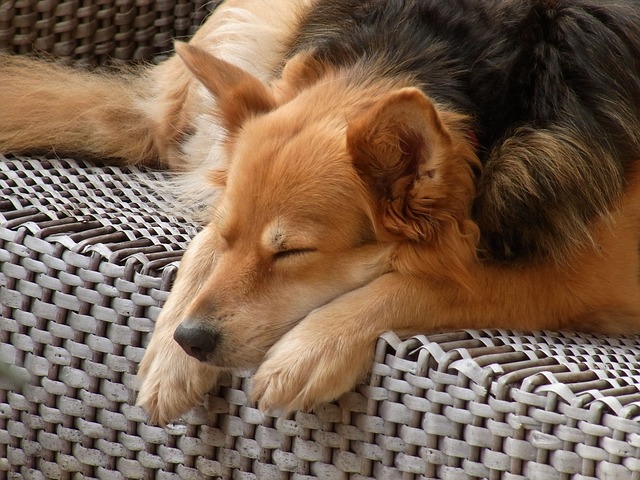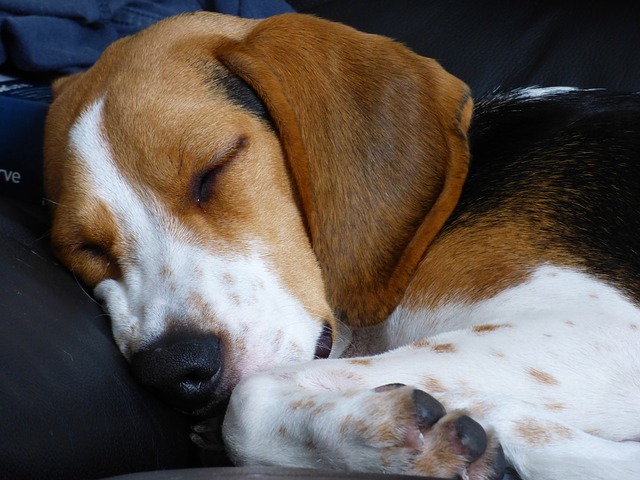Anyone who’s watched a pup wag her tail, bark, or even move her paws as if running in her sleep probably doesn’t need convincing that dogs can dream.
But are our companion’s nocturnal experiences similar to ours… and what exactly do they dream about?

How do we know that dogs dream?
A 2001 study by MIT determined that rats dream by measuring their brainwaves while completing a maze while they were awake. After measuring similar patterns while they slept, it was deducted that the rats were dreaming about the task they’d done that day.
If rats can dream, chances are, so can dogs, since they have more intellectual capacity. Matthew Wilson of MIT’s Center for Learning and Memory said in a story by MIT News:
“No one knew for certain that animals dreamed the way we do, which can involve replaying events or at least components of events that occurred while we were awake. We looked at the firing patterns of a collection of individual cells to determine the content of rats’ dreams. We know that they are in fact dreaming and their dreams are connected to actual experiences.”
Like us, dogs have sleep cycles and are thought to have their most vivid dreams during the REM cycle of sleep. A story by Psychology Today explains:
“During sleep the brain wave patterns of dogs are similar that of people, and go through the same stages of electrical activity observed in humans, all of which is consistent with the idea that dogs are dreaming.”

What do dogs dream about?
Well, as it turns out, we have that in common with our canine companions, too.
In an article by PEOPLE Pets, Dr. Deirdre Barrett, a teacher and a Clinical and Evolutionary Psychologist at Harvard Medical School, explains that our beloved pets probably dream about things from their daily lives – including their favorite humans.
“Humans dream about the same things they’re interested in by day, though more visually and less logically. There’s no reason to think animals are any different. Since dogs are generally extremely attached to their human owners, it’s likely your dog is dreaming of your face, your smell and of pleasing or annoying you.”
The article by Psychology Today further explains that dreams are often connected with memories of recent or impactful events. Therefore, it’s possible that your pup is reliving that rousing game of fetch you played earlier in the day! Matthew Wilson of MIT explains in the story:
“The animal is certainly recalling memories of those events as they occurred during the awake state, and it is doing so during dream sleep and that’s just what people do when they dream.”
What about twitching?
If you always thought that your dog’s mid-snooze twitches and barks indicate that he’s dreaming, you’re probably right.
According to Live Science, puppies and senior dogs tend to be especially “twitchy” in their sleep. One theory has to do with the pons, the mechanism in the brain that paralyzes large muscles while our pups get some shut-eye (same goes for us humans). The pons is what prevents our dogs from actually acting out what they’re visualizing, like chasing that dream-squirrel. However, this part of the brain may be underdeveloped in puppies and less effective in older dogs, making these age groups more active while they slumber.
Why you should follow the old adage, “let sleeping dogs lie”…
If there’s no reason to wake your pup from her slumber, it’s best that you don’t.
The American Kennel Club points out that, like us, dogs can be confused and disoriented when awoken mid-dream. But unlike us, startled dogs could bite. What’s more, no one likes to be woken up from a restful slumber! This is why it’s important for us to respect our dogs’ space while they’re sleeping and to teach children not to bother them during a nap.
Whenever possible, it’s best to “let sleeping dogs lie” and wait for your pooch to wake up naturally. But if you must rouse your pup, do it gently by quietly saying her name and giving her soft pets.
When your dog’s sleeping habits could indicate a medical issue…
Just like with any of your dog’s other behaviors — including eating, going to the bathroom, and their mannerisms — changes in sleep patterns should be noted and brought up to your vet.
The National Sleep Foundation explains that dogs sleep 12-14 hours a day, but of course this varies depending on breed and age. The most important thing to remember is that you know your pup’s routines best, and if something seems “off,” don’t ignore it.
Noticeable increases or decreases in sleep can indicate health problems, which “could be something as simple as tweaking his diet, or as complex as treating a heart condition or thyroid problem,” the site says. What’s more, an older dogs’ sudden wakefulness at night could indicate a change in the sleep-wake cycle that’s related to dementia.
If a dog’s unconscious movements (as mentioned above) are more like violent spasms than gentle twitches, it’s possible that they’re having a seizure. Chances are, pup parents will recognize that these pronounced movements are abnormal. If you’re ever unsure, it never hurts to talk to your vet.
Want to learn more about your canine’s adorable sleepy-time quirks? Find out about the meaning behind different snoozing positions here!


